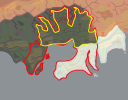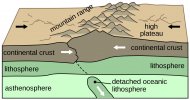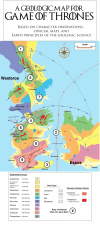works for meGood catch!
The little canon that exists on House Shett and their location is pretty confusing. I based the current position of the Gull Tower on the "semi-canon" quote given in the wiki. I just did a little more digging and it seems like this is extrapolated from a So Spake Martin entry:
(Typical GRRM justification...)
From what I've pieced together, the story with the Shetts goes something like the following:
1. Prior to the Andal invasion, the Shetts rule Gulltown as the Kings of the True Men, and wage intermittent war with the Bronze Kings of House Royce.
2. Under Osgood III Shett, the Shetts lost land to the Royces under King Yorwyck VI Royce and were pushed within the town walls.
3. Following the Andal invasion, the Shetts ally with the Andals in order to reclaim their land; Osgood III converts to the Faith and marries off his daughter to Gerold Grafton to seal the pact.
4. The Shetts and Graftons are victorious against the Royces, but Osgood III is killed in battle.
5. The remaining Shetts are betrayed by the Graftons; Gerold takes control of the city and Osgood III's heir is dispossessed.
6. At some point in the future, when King Robar II Royce rallied the First Men houses to fight against the Andals, his sister convinced the remaining Shetts to ally with them and rebel against the Graftons.
7. The Shetts allowed Robar's men to storm the city, which they ostensibly held for a short time.
8. However, after the decisive Andal victory at the Battle of the Seven Stars, the Shetts and Royces (what was left of them) both bent the knee to Artys I Arryn. Control of Gulltown was given back to the Graftons.
If the Shetts splintered into two surviving branches at some point, this would presumably have happened between events 4 and 6, where (at least some of) the Shetts formed an allegiance with the Royces. But the books aren't really clear about whether these are two surviving branches, or if one of the two is extinct.
Even if we go with the two branches interpretation, I think it's difficult to extrapolate a location for the branches just based on their allegiences. A lot of these allegiences were formed as a result of alliances during the Andal invasion; this also explains, for instance, why House Coldwater are vassals of the Royces despite being located all the way in the Fingers. In my opinion, it makes most sense to keep the Gull Tower inside of Gulltown due to this being the original historical seat of House Shett (as well as the canon that they were at one point pushed within the town walls), while the splinter branch sworn to the Royces would only come much later in the story (and would still have considerable control within Gulltown, given that they were able to open the gates for Robar's men). It's possible that both of the branches are within (or near) the city, and one (Damon Shett?) has control of the Gull Tower and the other (Uther Shett?) is a landed knight with some estate within (or near) Gulltown
The only thing I have trouble understanding is why house Shett is listed as bannermen to Yohn Royce. (see recent events, AFFC, https://awoiaf.westeros.org/index.php/House_Coldwater, strangely this information is not in the house Shett wiki) If this is accurate it seems too strange to have a vassel within the city of a rival lord, which would also suggest the Shetts would be able to raise a levy out of and tax a portion of the population of Gulltown which also seems strange. Would there be smallfolk within the city who have to serve them instead of the Graftons? (Actually to this point wouldn't a city have special rights to have the population exempt from conscription through the charter or something?) As I write this it occurred to me that perhaps a higher lord supports Gull Tower financially in exchange for their service to the city?
I can see the argument that this may be an oversite in canon and your explanation is reasonable if that is the case, and to tell you the truth I don't think it would be a very big deal if we swept this under the rug as such.
It's too bad GRRM doesn't put as much thought into the logistics of feudal obligations as we do lol.













